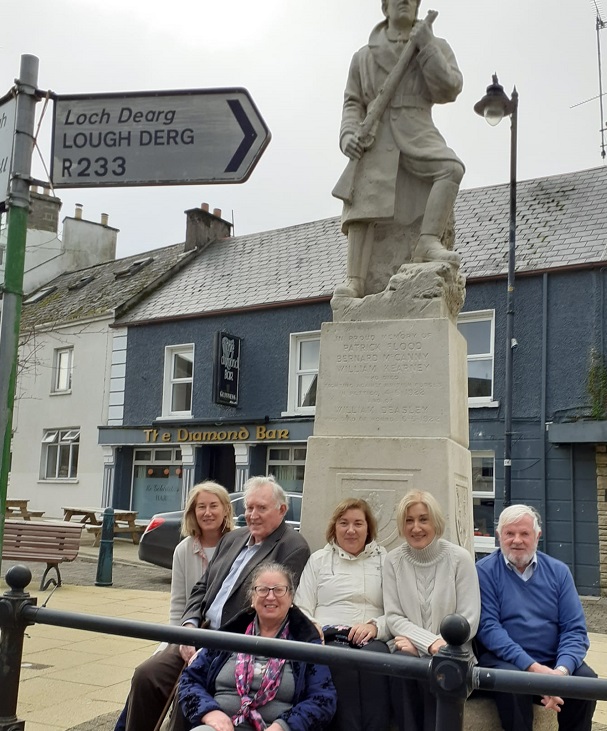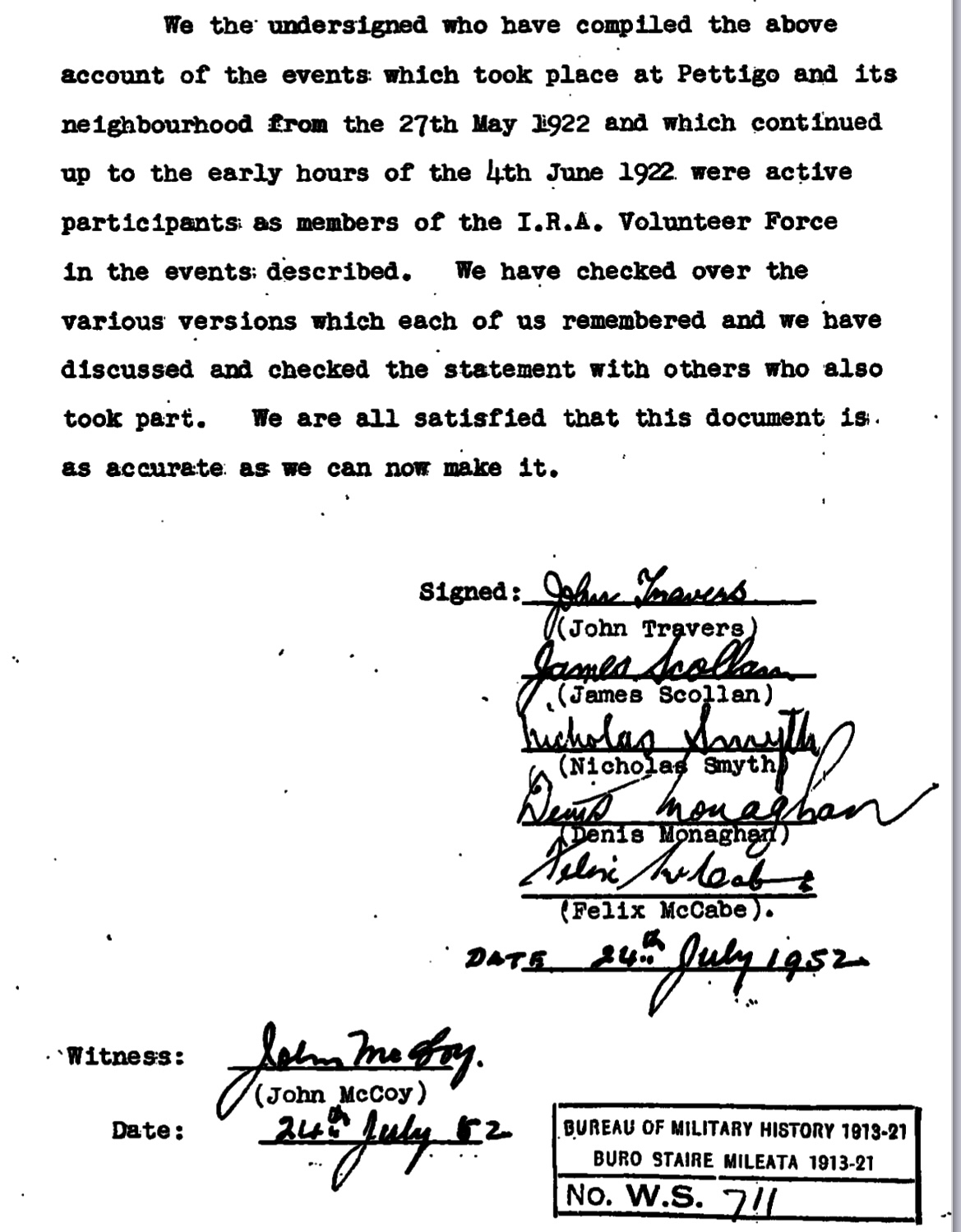
Members of the extended Travers family revisit Pettigo on centenary of infamous battle
A family who have deep personal connections with the Battle of Pettigo a century again, recently rounded up their own troops to make it back to Pettigo and remember their relative John Travers, who both participated in the famous direct battle with the British as well as being one of five people who recorded first hand eye witness testimony for the Irish Defence Forces military archive in the 1950s.
The late Mr Travers was also instrumental in helping raise funds for the memorial that now lies in the centre of the village to commemorate the Battle there and nearby Belleek in Co Fermanagh.
London based Gillian Travers, is a granddaughter of John Travers who explained that while she could not get to the special commemorative events back in May, the family felt duty bound to mark the important anniversary of a pivotal event in Irish history. This they were able to do over the October Bank Holiday weekend.
She said: “I travelled up at the October bank holiday with my cousins who are from Dublin and New Ross to coordinate with our Donegal relatives on a meet up during the commemorative year in 2022.
“John's son Aidan, my Dad, sadly passed away in 2011. His sister Nuala, John's daughter, and my aunt resides in Dublin.
“But at 86 years of age, it had been difficult to coordinate an earlier visit with Nuala, and daughter, John's granddaughter, Susan who lives in Kerry, but we were all most determined to get here.”
She explained that she was Aidan Travers' eldest daughter Gillian, and granddaughter of John.
Her granddad John died when she was just two weeks old and her family connection was heightened by the fact that she had graduated from TCD in History and has a keen interest in all things history.

Caption: Members of the late John Travers who participated in the Battle of Pettigo and whose first hand testimony in the Battle of Pettigo and Belleek (and that of James Scollan; Nicholas Smyth; Denis Monaghan; Felix McCabe.) are housed by the Bureau of Military History in Dublin. Included from left are Deirdre Travers, grandniece; Joseph Devenney, nephew; Maureen Travers, grandniece; Anne Travers, grandniece and Eunan Travers, nephew and in front, Gillian Travers, granddaughter.
She explained:
“We felt the extended Travers family should get those who could travel to Pertigo to do so before the commemorative year was out. The previous major nod to the Battle of Pettigo was in 1953 when the memorial was erected.
“Granddad John was also one of the signatories for the Irish army records, giving their account of the Battle of Pettigo between May 27 and June 4 1922 (Bureau of Military History Document WS 711).
“The volunteers initially blocked the bridge between Donegal and Fermanagh. The Battle is distinguished by the need for the British Government to dispatch army Battalions to Pettigo and Belleek.
“Winston Churchill had Michael Collins attend London regarding the activities in the border towns. Redolent of the famous ‘never have so many owed so much to so few’ quote from Churchill, we might wear it ourselves. One hundred volunteers pitted against the might of the British army was very brave,” Gillian admitted.

The statue which stands today in the centre of Pettigo
At the end of May, a special commemorative centenary event took place to remember a significant battle which took place on the Donegal/Fermanagh border, one hundred years ago.
The Battle of Pettigo/Belleek, took place along the Donegal/Fermanagh Border between late May, early June 1922 in the period between the War of Independence and the Civil War.
It was the last time that Pro and Anti Treaty Forces fought side-by-side against British forces.
It was part of Michael Collins's Northern Offensive, which was intended to destabilise the Unionist state, and was also a reaction to sectarian violence against nationalists in the North.
This was the only location in Ireland where Irish forces engaged with British forces in a stand-up fight with a defined battle line and the first time since the Easter Rising when heavy artillery was used in Ireland.
The sworn account in the Bureau of military history archives of the Irish Defence Forces, thirty years later gives a description of the epic battle and John Travers was one of the signatories:
"On Thursday, June 1st, a number of lorry loads of British soldiers followed by four Crossley loads of Specials advanced on the town of Pettigo. The Specials opened fire with rifles and machine guns on the I.R.A. Volunteer outposts stationed on Drumhariff Hill and at Pettigo railway station.
"The I.R.A. returned the fire and then the British soldiers joined in with rifles and machine guns. This engagement lasted an hour and a half during which a number of British soldiers were killed and a number wounded.
They then retreated. During Thursday and Friday nights there was intensive sniping at Pettigo by Specials which were now reinforced from Belfast.
"During Friday, June 2nd, and Saturday, June 3rd, the British commandeered all the boats on Lough Erne and assembled them at Portonode, from which they transported in them a battalion of British soldiers across the Lough to Boa Island.
They were marched through the Island and from thence they were transported in the boats to Letter which is two miles below Pettigo.
"In the meantime another battalion of British soldiers advanced during the night from Kesh to
Lowry with a view to joining the battalion at Letter. This would entail crossing the isthmus at the Waterfoot but the I.R.A. Volunteer outpost established there: since Monday were determined to prevent this union. All throughout Saturday night both battalions of British soldiers made repeated attacks on the I.R.A. Volunteers at the Waterfoot in the hope of dislodging them but they failed to do so.
"During the intense fighting on Saturday night a section of the I.R.A. Volunteers; crept from Pettigo, a distance of a mile, to assist their comrades at the Waterfoot. During the week, a large party of Specials had gone into Donegal through Lettercran which is five miles from Pettigo, and had terrorised the people, had shot and seriously wounded two girls.
"Now on this Saturday night of June 3rd this party of Specials, about two hundred, tried to cross at Lettercran from Fermanagh into Donegal so as to attack Pettigo from the rear but a party of I.R.A. Volunteers foreseeing their intentions intercepted them there and after a fierce engagement put them to flight burdened with their dead and wounded.
"The third engagement of this eventful night took place in Pettigo town. Two British Battalions tried in vain to take the town. Then on Sunday morning, June 14th, a fleet of armoured cars and infantry again attacked it but the driver of the leading armoured car was shot dead through the head and the car overturned and blocked the road.
"Fire from the Volunteers prevented them from clearing the way for some time.
At this stage a battery of Howitzers Artillery was brought into action by the British. Under this fire the unit of Volunteers covering the bridge was forced to withdraw to new positions and the British then cleared the obstructing car and the barricade at the bridge and advanced into the town.
"As this main thrust was being made, two other columns of British troops, that which had been stationed at Letter and another from the right by Lough Derg road, attempted to join forces so as to encircle the town, but fire from the Volunteers on each flank kept them at bay and left the escape route open to the main body of the Volunteers who withdrew to the hills and kept up a running fire until 5pm when they retreated to Donegal Town.
"But the machine gun post of about eight I.R.A. Volunteers which manned Drumhariff Hill covering the approach to the town, held their position until their ammunition Was exhausted and then the post was surrounded and captured.
"Three of the gallant defenders, Patrick Flood of Pettigo, Bernard McCanny and William Kearney of Drumquin, were killed at their post.
"While the fighting was taking place in Pettigo town, the post which manned the Waterfoot was heavily engaged by vastly superior numbers of British forces and were forced to surrender after two hours.
"Thus ended the Battle of Pettigo, a battle that is unique in two things, namely, it is the only place where there was a stand-up fight with a defined battle line and it is the only place in Ireland where artillery was used against the I.R.A.
"A monument is to be unveiled at Pettigo town on August 15th this year (1952) to commemorate those who died in that battle and in other engagements in the still unfree counties. It is expected that all surviving members of the Northern I.R.A. Brigades will be present at the unveiling ceremony.

John Travers was one of five who bore witness to the Battle of Pettigo one hundred years ago
"The following British Battalions took part in the Battle of Pettigo: - The Lincolnshires, The Manchesters, The Staffordshires, A Howitzer Battery, Airforce Details and the 2nd Battalion of the Scottish Borderers. There were in all twenty Battalions standing by.
"These Battalions of British soldiers were sent to Ulster by Mr. Winston Churchill, the then Secretary for War in England, on the advice of Field Marshal Sir Henry Wilson, Military Adviser to the "Ulster' Government, because the pick of his Specials had been routed by less than one hundred I.R.A. Volunteers in their teens who
withstood that final week under continuous fire without sleep or rest, although poorly armed mostly with weapons captured in earlier engagements.
"We the undersigned who have compiled the above account of the events which took place at Pettigo and its neighbourhood from the 27th May 1922 and which continued up to the early hours of the 14th June 1922 were active participants as members of the I.R.A. Volunteer Force in the events described.
"We have checked over the various versions which each of us remembered and we have discussed and checked the statement with others who also took part. We are all satisfied that this document is as accurate as we can now make it.
Signed: John Travers; James Scollan; Nicholas Smyth; Denis Monaghan; Felix McCabe. Date 24th July 1952
Witness: John McCoy.
** A fourth person, Willian Deasley later died from wounds inflicted during the same battle.
Subscribe or register today to discover more from DonegalLive.ie
Buy the e-paper of the Donegal Democrat, Donegal People's Press, Donegal Post and Inish Times here for instant access to Donegal's premier news titles.
Keep up with the latest news from Donegal with our daily newsletter featuring the most important stories of the day delivered to your inbox every evening at 5pm.